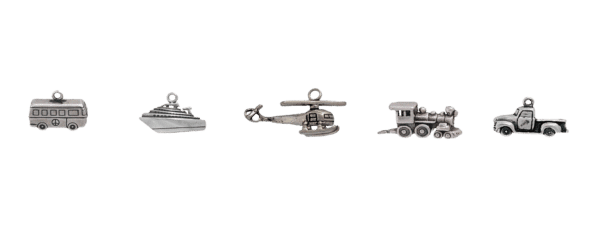
Transportation Modes
Lovers of wide-open roads – rejoice! Fully express your creative streak and all your great ideas for transportation-themed charms with Xinar’s transportation modes charms in 925 sterling silver. We have a wide assortment of charms to choose from, including car charms (like this silver Chevy charm), Wheel RV trailer charm, full-sized bus charm, and more! Xinar has sold high-quality jewelry-making supplies in semi-precious metals for over twenty years.
We have grown alongside countless creatives, artists, jewelry designers, and DIY crafters over two decades in the business, and we would love nothing more than to assist you in finding what you need to complete your workbench needs fully. Also, if you need sterling silver beads and findings, navigate our site using the menu above, and you will find what you need. Then, use our search bar to find what you need instantly. You never know what you will find in Xinar’s extensive jewelry-making catalog!
A Brief History of Transportation
Humans have always sought to move worldwide, whether by land or sea. It is impossible to predict where and how transportation will take us in the future. However, we have already gone from simple canoes to space travel. The following is a transportation timeline, starting with the first 900,000-year-old vehicles and ending in the present day.
Boats were the first means of transportation devised specifically for crossing waterways. The first people to cross the ocean have been attributed to those who first colonized Australia around 60,000–40,000 years ago, but there is evidence that pelagic trips took place as far back as 900,000 years ago.
Logboats, also known as dugouts, were the earliest known boats, and they were constructed by hollowing out a tree trunk. Artifacts dating back between 10,000 and 7,000 years support floating vehicles’ existence. The Pesse canoe, a logboat, dates back to 7600 BCE, making it the oldest boat ever discovered. Artifacts dating back 8,000 years show that rafts have been around almost as long.
After that, there were the horses. To determine when humans first began domesticating them as a means of transportation and carrying goods, experts generally look to the development of specific human biomarkers and cultural traits that indicate when such practices began to occur.
Experts believe that domestication occurred around 4000 BCE, based on changes in teeth records, butchering activities, shifts in settlement patterns, and historical depictions. This is corroborated by evidence gathered from horse genomes, which show alterations in muscle structure and cognition.
The wheel was also invented roughly during this period. In 3500 BC, archaeologists found evidence of wheeled vehicles in Mesopotamia, the Northern Caucuses, and Central Europe. The “Bronocice pot,” a ceramic vase depicting a four-wheeled wagon with two axles, is the earliest well-dated artifact from that period. Polish archaeologists discovered it in the southern part of the country.
The invention of the Watt steam engine in 1769 altered the course of history. France’s Claude de Jouffroy built the “Pyroscaphe,” the world’s first steamship, in 1783. However, after successfully ferrying people up and down the river in the course of a demo, there was not enough demand to justify further development funding.
The American Robert Fulton took steamship technology to the point of commercial viability while other inventors failed miserably. In 1807, a trip from New York City to Albany required 32 hours.
The “Roper Steam Velocipede” attempted to repurpose the steam engine for personal transportation. One of the first motorcycles was a two-wheeled steam-powered bicycle developed in 1867.
The locomotive was a steam-powered mode of land transportation that became popular. To get to a nearby village, Richard Trevithick, a British inventor, unveiled the “Puffing Devil,” the world’s first road locomotive, in 1801. Three years later, Trevithick showed off a rail-powered locomotive and another that could tow 10 tons of iron from the Welsh village of Penydarren to Abercynon.
George Stephenson, a British civil and mechanical engineer, was the man who made mass transportation possible with locomotives.
$12.95
All aboard! Chug onto new horizons with our gleaming Sterling Silver Train Engine Charm. Crafted in polished 925 silver, this intricate engine evokes wanderlust and nostalgia. Add a touch of vintage travel flair to any bracelet or necklace. Where will your next adventure take you?
$7.95
Home is wherever you park it: Celebrate the nomadic spirit with our Sterling Silver Travel Trailer Charm.Add it to your jewelry collection as a tribute to your love of travel, camping, or the simple pleasure of exploring new horizons. It’s for any free spirit who calls the open road home.
$9.95
Embark on a mini Thai adventure with our adorable Sterling Silver Tuk Tuk Taxi Charm! Featuring Thailand’s iconic taxi, this detailed pendant is crafted with intricate details and vibrant colors. Add a touch of Southeast Asian flair to your travels!
$8.95
Rekindle the nostalgia of vintage road trips with our detailed Sterling Silver Woody Station Wagon Charm. This charming pendant, crafted in polished silver, evokes memories of family adventures and sun-drenched summers. Add a touch of retro flair to your bracelet or necklace.
The domestic shipping charge is a flat rate of $3.95, no matter how many items you wish to purchase.
Priority mail is a flat rate of $8.25.
Canada shipping is a flat rate of $15.00.
International shipping is a flat rate of $17.00.
Items shipped via United States Postal Service with tracking.